You might have seen our new Cubelets video. It blew up the internet a little bit last week and we were pretty excited to watch the real-time traffic and pre-orders roll in. The best part is reading and hearing the diverse feedback from the web.
One thing is clear: some Dutch people seem to have a little bit of self-hatred about their accents. Please don’t!. We have a lot of Dutch friends at Modular Robotics and we love speaking English with you. Your accent is melodic and sometimes totally hilarious. Did you notice that the voice is overdubbed? Nobody else noticed either.
We shot the video last Summer at Oli’s cabin in Conifer, Colorado. It was an epic day of fliming, Cubelets fiddling, and snacking on Edam. We’ve been editing and preparing it since then. I think the video is just straight awesome and I’m happy to share it with you. Thanks Evan, Justin, Todd, and our friends at BlorpCorp.
Category: Uncategorized
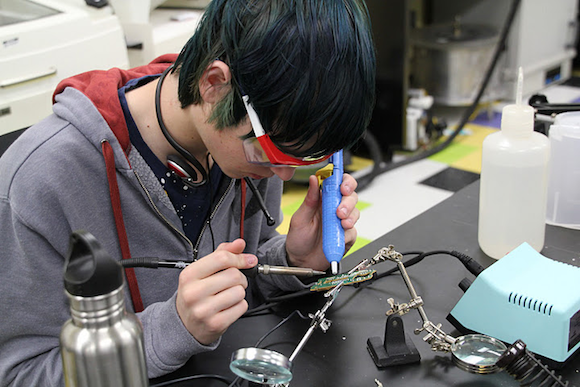 Last weekend I spoke at Paulo Blikstein’s FabLearn symposium at the Center for Educational Research at Stanford. Paulo has a well-equipped fabrication lab (Transformative Learning Technologies Lab) and a gaggle of great graduate students, and a mission to engage young people in fabrication: FabLab@School. FabLearn focused on integrating fabrication technologies into secondary education, attracting ~45 outstanding STEM educators from both formal (school) and informal (museums, after-school, and summer camps) sectors. My chum Mike Eisenberg (Craft Tech Lab, Colorado) argued for an approach to education that integrates making into children’s lives (an “anthropological approach”), rather than diagnosing and repairing cognitive deficiencies; Dale Dougherty (MAKE) spoke about efforts to build Maker communities, and Neil Gershenfeld (MIT Media Lab) laid out the Bits & Atoms vision and FabLab spinoffs. I talked about construction kits and showed Cubelets. Excellent cross-talk and optimism about how making things engages kids in learning. Kudos to Paulo for making it happen, and Modular Robotics was happy to be there.
Last weekend I spoke at Paulo Blikstein’s FabLearn symposium at the Center for Educational Research at Stanford. Paulo has a well-equipped fabrication lab (Transformative Learning Technologies Lab) and a gaggle of great graduate students, and a mission to engage young people in fabrication: FabLab@School. FabLearn focused on integrating fabrication technologies into secondary education, attracting ~45 outstanding STEM educators from both formal (school) and informal (museums, after-school, and summer camps) sectors. My chum Mike Eisenberg (Craft Tech Lab, Colorado) argued for an approach to education that integrates making into children’s lives (an “anthropological approach”), rather than diagnosing and repairing cognitive deficiencies; Dale Dougherty (MAKE) spoke about efforts to build Maker communities, and Neil Gershenfeld (MIT Media Lab) laid out the Bits & Atoms vision and FabLab spinoffs. I talked about construction kits and showed Cubelets. Excellent cross-talk and optimism about how making things engages kids in learning. Kudos to Paulo for making it happen, and Modular Robotics was happy to be there.
I’ve just returned to the USA from a few days in Berlin for the Create Art and Technology 2011 conference. What an amazing city! Berlin is extremely vibrant; people are young and international and the city is packed with co-op hackerspaces and design studios. I flew overnight, arrived at 7am and promptly took myself on a ten-hour walking tour.
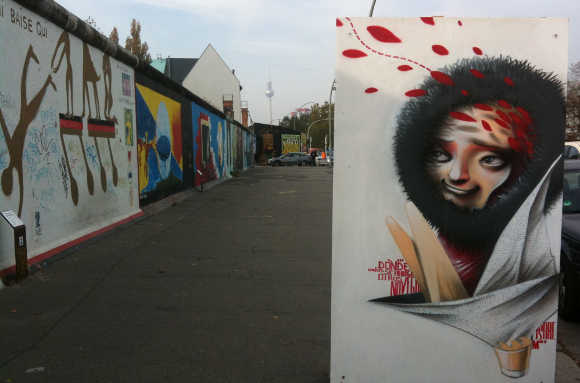 When the wall was torn down, a 1500 meter long section was left standing and turned into a gallery. Street artists have co-opted little sections of the wall and turned them into recollections of life in the GDR. But there is amazing street art everywhere! I kept going, stopped periodically in an interesting cafe for a cappuccino or four, and wandered past the Brandenburg Gate, squatter villages, the TV tower, and the Reichstag. The photo below is just of a regular old street with the U-Bahn train passing above — it’s pretty easy to get around Berlin at all hours.
When the wall was torn down, a 1500 meter long section was left standing and turned into a gallery. Street artists have co-opted little sections of the wall and turned them into recollections of life in the GDR. But there is amazing street art everywhere! I kept going, stopped periodically in an interesting cafe for a cappuccino or four, and wandered past the Brandenburg Gate, squatter villages, the TV tower, and the Reichstag. The photo below is just of a regular old street with the U-Bahn train passing above — it’s pretty easy to get around Berlin at all hours.
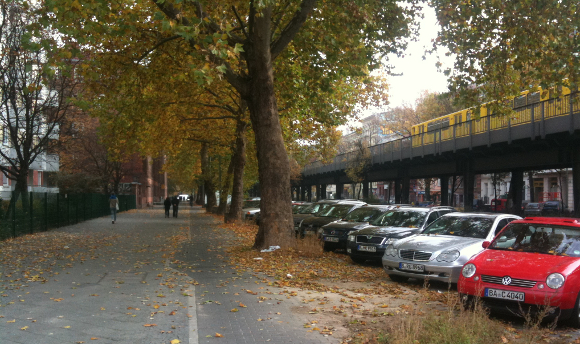 The conference was a blast. It was the first of its kind and was put on by Anton Mezhiborskiy from Tinker Soup and Stefan Canditt from Formulor mostly as an excuse to bring a bunch of interesting people and projects together for a big ideation session. Grace Kim showed off some cool wearable electronics and Will Light showed off his library for the Monome by way of a quick DJ set. Onyx Ashanti played some BeatJazz and fun was had by all. I gave a talk on the evolution of Cubelets from idea to project to prototype to project and also led a couple of two-hour workshops on reprogramming with a Bluetooth Cubelet.
The conference was a blast. It was the first of its kind and was put on by Anton Mezhiborskiy from Tinker Soup and Stefan Canditt from Formulor mostly as an excuse to bring a bunch of interesting people and projects together for a big ideation session. Grace Kim showed off some cool wearable electronics and Will Light showed off his library for the Monome by way of a quick DJ set. Onyx Ashanti played some BeatJazz and fun was had by all. I gave a talk on the evolution of Cubelets from idea to project to prototype to project and also led a couple of two-hour workshops on reprogramming with a Bluetooth Cubelet.
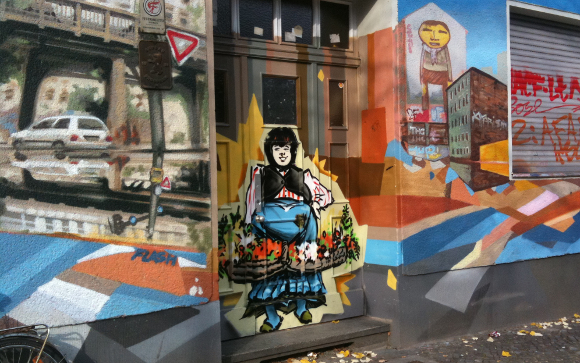 The conference was held at Planet Modulor, a city block-sized building that houses a variety of design studios, laser cutter shops, art galleries, an architectural model supply store, and even a kindergarten. When we encountered a problem with wi-fi at the conference venue, though, Jay invited us to hold the workshops a few blocks away at Open Design City, a co-working space with shop tools, a CNC machine in progress, and a variety of people hacking around on all sorts of projects. Berlin blew me away; it seemed that behind every door there was a group of makers diligently trying to change the world.
The conference was held at Planet Modulor, a city block-sized building that houses a variety of design studios, laser cutter shops, art galleries, an architectural model supply store, and even a kindergarten. When we encountered a problem with wi-fi at the conference venue, though, Jay invited us to hold the workshops a few blocks away at Open Design City, a co-working space with shop tools, a CNC machine in progress, and a variety of people hacking around on all sorts of projects. Berlin blew me away; it seemed that behind every door there was a group of makers diligently trying to change the world.
 When the wall was torn down, a 1500 meter long section was left standing and turned into a gallery. Street artists have co-opted little sections of the wall and turned them into recollections of life in the GDR. But there is amazing street art everywhere! I kept going, stopped periodically in an interesting cafe for a cappuccino or four, and wandered past the Brandenburg Gate, squatter villages, the TV tower, and the Reichstag. The photo below is just of a regular old street with the U-Bahn train passing above — it’s pretty easy to get around Berlin at all hours.
When the wall was torn down, a 1500 meter long section was left standing and turned into a gallery. Street artists have co-opted little sections of the wall and turned them into recollections of life in the GDR. But there is amazing street art everywhere! I kept going, stopped periodically in an interesting cafe for a cappuccino or four, and wandered past the Brandenburg Gate, squatter villages, the TV tower, and the Reichstag. The photo below is just of a regular old street with the U-Bahn train passing above — it’s pretty easy to get around Berlin at all hours.
 The conference was a blast. It was the first of its kind and was put on by Anton Mezhiborskiy from Tinker Soup and Stefan Canditt from Formulor mostly as an excuse to bring a bunch of interesting people and projects together for a big ideation session. Grace Kim showed off some cool wearable electronics and Will Light showed off his library for the Monome by way of a quick DJ set. Onyx Ashanti played some BeatJazz and fun was had by all. I gave a talk on the evolution of Cubelets from idea to project to prototype to project and also led a couple of two-hour workshops on reprogramming with a Bluetooth Cubelet.
The conference was a blast. It was the first of its kind and was put on by Anton Mezhiborskiy from Tinker Soup and Stefan Canditt from Formulor mostly as an excuse to bring a bunch of interesting people and projects together for a big ideation session. Grace Kim showed off some cool wearable electronics and Will Light showed off his library for the Monome by way of a quick DJ set. Onyx Ashanti played some BeatJazz and fun was had by all. I gave a talk on the evolution of Cubelets from idea to project to prototype to project and also led a couple of two-hour workshops on reprogramming with a Bluetooth Cubelet.
 The conference was held at Planet Modulor, a city block-sized building that houses a variety of design studios, laser cutter shops, art galleries, an architectural model supply store, and even a kindergarten. When we encountered a problem with wi-fi at the conference venue, though, Jay invited us to hold the workshops a few blocks away at Open Design City, a co-working space with shop tools, a CNC machine in progress, and a variety of people hacking around on all sorts of projects. Berlin blew me away; it seemed that behind every door there was a group of makers diligently trying to change the world.
The conference was held at Planet Modulor, a city block-sized building that houses a variety of design studios, laser cutter shops, art galleries, an architectural model supply store, and even a kindergarten. When we encountered a problem with wi-fi at the conference venue, though, Jay invited us to hold the workshops a few blocks away at Open Design City, a co-working space with shop tools, a CNC machine in progress, and a variety of people hacking around on all sorts of projects. Berlin blew me away; it seemed that behind every door there was a group of makers diligently trying to change the world.
Are you in Boulder, CO? Interested in taking your Cubelets robots to the next level? Join us for a short workshop on building and programming Cubelets. This is sort of a practice workshop — we’re giving some demos all over the world in the next few months so we thought we’d try it out with our local friends first. It’ll be very experimental — experimental enough that our test Bluetooth Cubelets are are actually spray-painted since we don’t have light blue plastic yet. This workshop will include some finicky text-based programming, so it’s not for the little ones – I think that age 12 and up is about right.
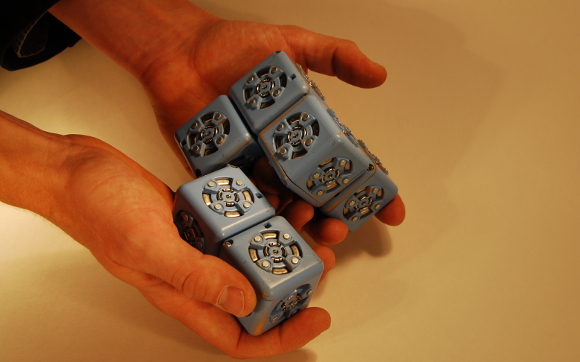
- When: Tuesday, Nov. 1, 2011, 5:00-7:00pm
- Where: Modular Robotics, 1645 Canyon Blvd., Boulder, CO, USA (map)
- Bring: A Windows laptop if you have one handy.
Please RSVP by commenting below. We only have room for the first ten people!

It’s always exciting to open up a new shipment of Cubelet parts. After the UPS truck has gone and we’re left with a pile of boxes, we tend to gather around with a bit of trepidation to see what’s inside. Some of our suppliers are boring — they always send us what we order. But our custom parts tend to be much more exciting. We never know what will be inside an innocuous shipping crate.
Most of our custom parts are made at factories in mainland China. We have a metal stamping factory in the North, a magnet factory in Ningbo, a PCB factory in Wuhan, and our injection molder in the South, in Guangdong Province. Eleven other factories make things like gears, screws, spring pins, etc. I’ve been working directly with our suppliers now for three years, and I’ll be the first to admit that coordination and communication is a serious challenge. It’s hard to get the right parts.
Our main challenge now seems to be getting our suppliers to send us the same parts as they did for the last order. Almost across the board, we’ll place a re-order (“please send us 10,000 more of the exact same widget as before”) and receive something different. It’s weird: metal parts stamped from a different material, spring pins plated differently, PCBs of the wrong thickness, and plastic parts in the wrong color. Honestly? It’s driving me crazy.
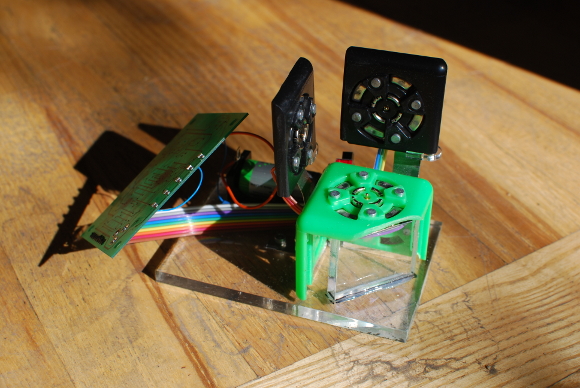 The latest problem popped up on Friday soon after we received 12 boxes (twelve boxes! it’s expensive to ship 12 boxes from China to the US!) of plastic Cubelet halves. We began assembling them into Cubelets only to find that they were all failing our connectivity test. The little test rig shown above is made of three Cubelet pieces on a sprung platform. As we assemble each Cubelet, we pop it in here and a series of tiny LEDs lights up to check for connectivity and short circuits. We’ve built a different jig for every Cubelet type that runs a specific set of tests on the electronics and hardware.
The latest problem popped up on Friday soon after we received 12 boxes (twelve boxes! it’s expensive to ship 12 boxes from China to the US!) of plastic Cubelet halves. We began assembling them into Cubelets only to find that they were all failing our connectivity test. The little test rig shown above is made of three Cubelet pieces on a sprung platform. As we assemble each Cubelet, we pop it in here and a series of tiny LEDs lights up to check for connectivity and short circuits. We’ve built a different jig for every Cubelet type that runs a specific set of tests on the electronics and hardware.
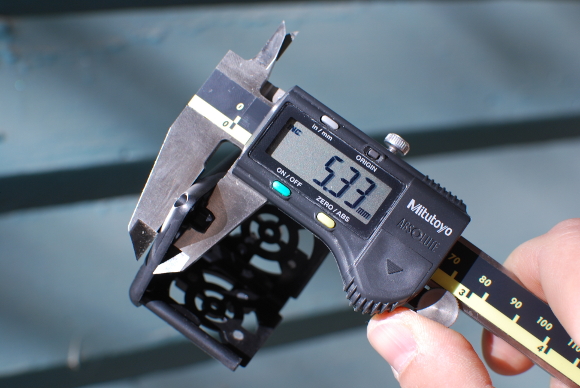 After some fiddling and measuring, we found that the plastic pieces were molded wrong. The base thickness is supposed to be 5mm with a tolerance of 0.075mm. And these were all 5.3mm thick. 0.3mm doesn’t sound like a lot, but it’s more than enough to prevent Cubelets from communicating with neighboring Cubelets. The upshot? All of the plastic casings are bad. This is unfortunate for three reasons.
Resources. It’s unfortunate because we now have a few huge boxes of plastic and metal parts that are now useless — it’s a shameful waste. It took a fair amount of energy and petrochemicals to make these plastic bits, and now they sit. We’re thinking about how we might go about cracking the plastic, removing the magnets, and recycling them separately, but even this process will require more energy input. Normally, I’m OK with making our plastic widgets because I’m confident that they’re changing kids’ minds. But making useless plastic widgets makes me feel guilty.
Money. This mistake is also unfortunate because it’s expensive. It turns out to be about a $40,000 mistake, and we don’t have piles of money on hand to deal with problems like this. We’re funded by the National Science Foundation and a few other investors, and money wasted on stuff like this is money that gets diverted away from fun projects like new Cubelets. The most irritating part of this for me? We pay a Quality Assurance company to check every plastic part before it’s put in the box for shipment to us. It seems that arrangement has not worked out.
Time. The third effect of this problem is that it puts us behind schedule. We have 250 outstanding pre-orders for Cubelets, eager buyers emailing every day, and the holiday season creeping up. It actually takes about five weeks to get new plastic made: first, the magnets are custom milled, then they’re sent to the injection molder to be embedded into the plastic. Then everything gets put on a plane to Boulder, CO.
Well. I wanted to let you what we’re up to and why we don’t have a Buy It Now button next to the Cubelets on our site. I hope it didn’t come across as a rant. We’re adapting and getting replacement plastic and magnets molded and shipped as quickly as possible, and we’ll carry on making as many Cubelets as we can. Hardware is hard.
After some fiddling and measuring, we found that the plastic pieces were molded wrong. The base thickness is supposed to be 5mm with a tolerance of 0.075mm. And these were all 5.3mm thick. 0.3mm doesn’t sound like a lot, but it’s more than enough to prevent Cubelets from communicating with neighboring Cubelets. The upshot? All of the plastic casings are bad. This is unfortunate for three reasons.
Resources. It’s unfortunate because we now have a few huge boxes of plastic and metal parts that are now useless — it’s a shameful waste. It took a fair amount of energy and petrochemicals to make these plastic bits, and now they sit. We’re thinking about how we might go about cracking the plastic, removing the magnets, and recycling them separately, but even this process will require more energy input. Normally, I’m OK with making our plastic widgets because I’m confident that they’re changing kids’ minds. But making useless plastic widgets makes me feel guilty.
Money. This mistake is also unfortunate because it’s expensive. It turns out to be about a $40,000 mistake, and we don’t have piles of money on hand to deal with problems like this. We’re funded by the National Science Foundation and a few other investors, and money wasted on stuff like this is money that gets diverted away from fun projects like new Cubelets. The most irritating part of this for me? We pay a Quality Assurance company to check every plastic part before it’s put in the box for shipment to us. It seems that arrangement has not worked out.
Time. The third effect of this problem is that it puts us behind schedule. We have 250 outstanding pre-orders for Cubelets, eager buyers emailing every day, and the holiday season creeping up. It actually takes about five weeks to get new plastic made: first, the magnets are custom milled, then they’re sent to the injection molder to be embedded into the plastic. Then everything gets put on a plane to Boulder, CO.
Well. I wanted to let you what we’re up to and why we don’t have a Buy It Now button next to the Cubelets on our site. I hope it didn’t come across as a rant. We’re adapting and getting replacement plastic and magnets molded and shipped as quickly as possible, and we’ll carry on making as many Cubelets as we can. Hardware is hard.
 The latest problem popped up on Friday soon after we received 12 boxes (twelve boxes! it’s expensive to ship 12 boxes from China to the US!) of plastic Cubelet halves. We began assembling them into Cubelets only to find that they were all failing our connectivity test. The little test rig shown above is made of three Cubelet pieces on a sprung platform. As we assemble each Cubelet, we pop it in here and a series of tiny LEDs lights up to check for connectivity and short circuits. We’ve built a different jig for every Cubelet type that runs a specific set of tests on the electronics and hardware.
The latest problem popped up on Friday soon after we received 12 boxes (twelve boxes! it’s expensive to ship 12 boxes from China to the US!) of plastic Cubelet halves. We began assembling them into Cubelets only to find that they were all failing our connectivity test. The little test rig shown above is made of three Cubelet pieces on a sprung platform. As we assemble each Cubelet, we pop it in here and a series of tiny LEDs lights up to check for connectivity and short circuits. We’ve built a different jig for every Cubelet type that runs a specific set of tests on the electronics and hardware.
 After some fiddling and measuring, we found that the plastic pieces were molded wrong. The base thickness is supposed to be 5mm with a tolerance of 0.075mm. And these were all 5.3mm thick. 0.3mm doesn’t sound like a lot, but it’s more than enough to prevent Cubelets from communicating with neighboring Cubelets. The upshot? All of the plastic casings are bad. This is unfortunate for three reasons.
Resources. It’s unfortunate because we now have a few huge boxes of plastic and metal parts that are now useless — it’s a shameful waste. It took a fair amount of energy and petrochemicals to make these plastic bits, and now they sit. We’re thinking about how we might go about cracking the plastic, removing the magnets, and recycling them separately, but even this process will require more energy input. Normally, I’m OK with making our plastic widgets because I’m confident that they’re changing kids’ minds. But making useless plastic widgets makes me feel guilty.
Money. This mistake is also unfortunate because it’s expensive. It turns out to be about a $40,000 mistake, and we don’t have piles of money on hand to deal with problems like this. We’re funded by the National Science Foundation and a few other investors, and money wasted on stuff like this is money that gets diverted away from fun projects like new Cubelets. The most irritating part of this for me? We pay a Quality Assurance company to check every plastic part before it’s put in the box for shipment to us. It seems that arrangement has not worked out.
Time. The third effect of this problem is that it puts us behind schedule. We have 250 outstanding pre-orders for Cubelets, eager buyers emailing every day, and the holiday season creeping up. It actually takes about five weeks to get new plastic made: first, the magnets are custom milled, then they’re sent to the injection molder to be embedded into the plastic. Then everything gets put on a plane to Boulder, CO.
Well. I wanted to let you what we’re up to and why we don’t have a Buy It Now button next to the Cubelets on our site. I hope it didn’t come across as a rant. We’re adapting and getting replacement plastic and magnets molded and shipped as quickly as possible, and we’ll carry on making as many Cubelets as we can. Hardware is hard.
After some fiddling and measuring, we found that the plastic pieces were molded wrong. The base thickness is supposed to be 5mm with a tolerance of 0.075mm. And these were all 5.3mm thick. 0.3mm doesn’t sound like a lot, but it’s more than enough to prevent Cubelets from communicating with neighboring Cubelets. The upshot? All of the plastic casings are bad. This is unfortunate for three reasons.
Resources. It’s unfortunate because we now have a few huge boxes of plastic and metal parts that are now useless — it’s a shameful waste. It took a fair amount of energy and petrochemicals to make these plastic bits, and now they sit. We’re thinking about how we might go about cracking the plastic, removing the magnets, and recycling them separately, but even this process will require more energy input. Normally, I’m OK with making our plastic widgets because I’m confident that they’re changing kids’ minds. But making useless plastic widgets makes me feel guilty.
Money. This mistake is also unfortunate because it’s expensive. It turns out to be about a $40,000 mistake, and we don’t have piles of money on hand to deal with problems like this. We’re funded by the National Science Foundation and a few other investors, and money wasted on stuff like this is money that gets diverted away from fun projects like new Cubelets. The most irritating part of this for me? We pay a Quality Assurance company to check every plastic part before it’s put in the box for shipment to us. It seems that arrangement has not worked out.
Time. The third effect of this problem is that it puts us behind schedule. We have 250 outstanding pre-orders for Cubelets, eager buyers emailing every day, and the holiday season creeping up. It actually takes about five weeks to get new plastic made: first, the magnets are custom milled, then they’re sent to the injection molder to be embedded into the plastic. Then everything gets put on a plane to Boulder, CO.
Well. I wanted to let you what we’re up to and why we don’t have a Buy It Now button next to the Cubelets on our site. I hope it didn’t come across as a rant. We’re adapting and getting replacement plastic and magnets molded and shipped as quickly as possible, and we’ll carry on making as many Cubelets as we can. Hardware is hard.
As a new member of the modrobotics team, part of my fun is hacking together new and exciting Cubelets! Over the coming weeks and months, I’ll be posting some of our behind-the-scenes Cubelet hacks we’re playing with here in the lab. Any of these could end up as production Cubelets, especially if you make your desires heard.
We have a backlist of new ideas, but we’ve also got eyes on our forum for suggestions, which is exactly where the first idea in this series came from: the roller Cubelet. (Thank you to Michael Tarr for the suggestion!)
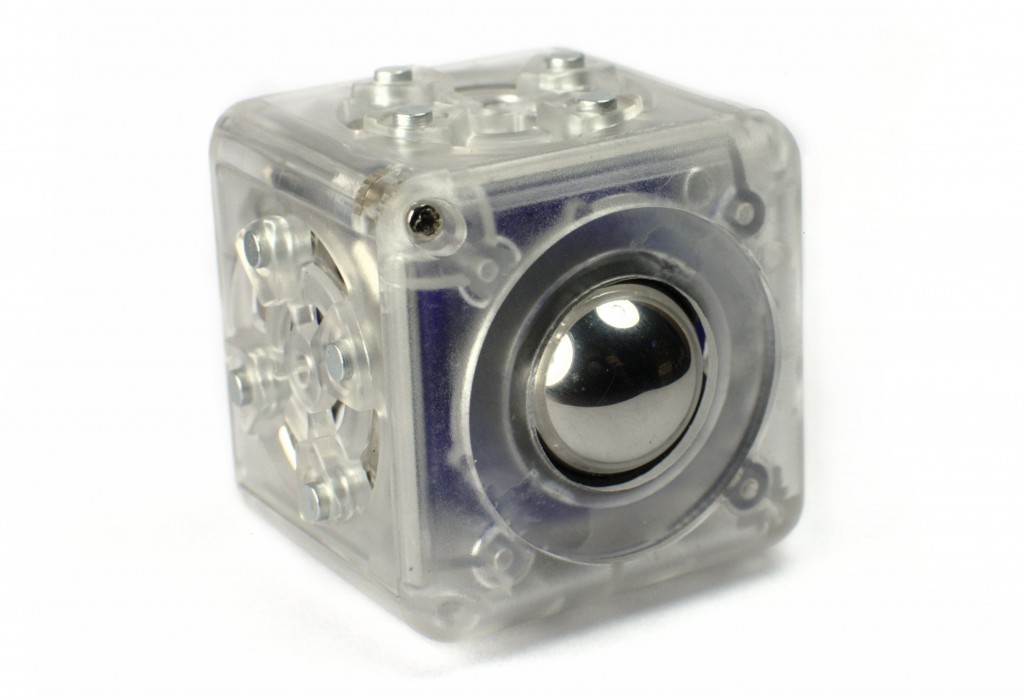 After getting our hands on a roller ball and housing, we heisted a rotate block shell which had an appropriate size opening. After 45 minutes of running up and down from computer to the laser cutter and juggling little screws with a couple drops of super glue for good measure, we have the result you see here. The ball sticks down the same amount as the drive blocks to make a low friction omni-directional point of contact with the ground. Stable robots are happy robots!
More Cubelet hacks are coming! Stay tuned and flip over to the forum if you have any Cubelets you want us to make.
After getting our hands on a roller ball and housing, we heisted a rotate block shell which had an appropriate size opening. After 45 minutes of running up and down from computer to the laser cutter and juggling little screws with a couple drops of super glue for good measure, we have the result you see here. The ball sticks down the same amount as the drive blocks to make a low friction omni-directional point of contact with the ground. Stable robots are happy robots!
More Cubelet hacks are coming! Stay tuned and flip over to the forum if you have any Cubelets you want us to make.
 After getting our hands on a roller ball and housing, we heisted a rotate block shell which had an appropriate size opening. After 45 minutes of running up and down from computer to the laser cutter and juggling little screws with a couple drops of super glue for good measure, we have the result you see here. The ball sticks down the same amount as the drive blocks to make a low friction omni-directional point of contact with the ground. Stable robots are happy robots!
More Cubelet hacks are coming! Stay tuned and flip over to the forum if you have any Cubelets you want us to make.
After getting our hands on a roller ball and housing, we heisted a rotate block shell which had an appropriate size opening. After 45 minutes of running up and down from computer to the laser cutter and juggling little screws with a couple drops of super glue for good measure, we have the result you see here. The ball sticks down the same amount as the drive blocks to make a low friction omni-directional point of contact with the ground. Stable robots are happy robots!
More Cubelet hacks are coming! Stay tuned and flip over to the forum if you have any Cubelets you want us to make.
In July, we shipped out our first production run of 100 “beta test” KT01 20-Cubelet kits. That might not sound like a lot of robots, but 100 kits means 2000 Cubelets. Each Cubelet has 6 circuit boards and 24 tiny magnets in it, so the quantities were actually pretty large.
Our first 100 customers were extremely patient. Some of them pre-ordered Cubelets back in October 2010 and waited patiently while we dealt with some manufacturing, material, and supplier challenges. But Cubelets are finally out in the world.
We’re busy manufacturing our second run (5000 Cubelets this time), but our early-adopter friends have already started posting reviews and videos of their first experiments and play sessions. They’re definitely worth looking at.
- Jonas at Cornell posted a video of some creative robots he’s built.
- Carl in New Zealand writes a thoughtful review of the Cubelets KT01 kit.
- Per at the Flexibility Envelope shot an unboxing video with some initial impressions.
I gave a talk at the University of Colorado’s Computer Science Colloquium a couple of months ago. It’s kind of long (and totally unedited), but if you’re curious about the history of Cubelets and some other related projects, here you go:
I’m excited, and I’ll admit: a little bit amazed. Today we’re shipping out the first Cubelets kits to our eager pre-order community. I’ve been working on Cubelets since 2006; first as a PhD project, then as a fledgling idea in my garage, and now as a real company with a team of 9 people. Five years in the making, and today we’re carrying boxes down to UPS and watching them roll down the conveyor belt. It’s been so long in the making that I keep pinching myself to make sure I’m not dreaming. We’re really shipping out products!
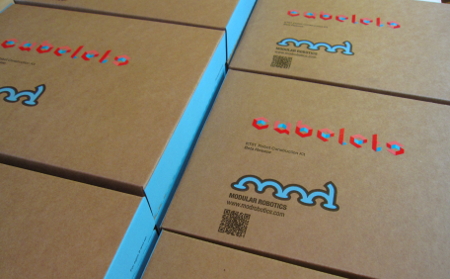 Assembly has taken us a lot longer than I had estimated (even though experience in these things has taught me to triple any time estimates). We were pretty accurate in planning for all the “real” assembly tasks like soldering, screwing, folding, calibrating, and programming, but all of the other miscellaneous tasks crept up on us: things like opening boxes, organizing parts, carrying things around, building shelves and charging batteries. Yesterday I saw something that none of us has ever seen before: we killed an entire one pound roll of solder.
Assembly has taken us a lot longer than I had estimated (even though experience in these things has taught me to triple any time estimates). We were pretty accurate in planning for all the “real” assembly tasks like soldering, screwing, folding, calibrating, and programming, but all of the other miscellaneous tasks crept up on us: things like opening boxes, organizing parts, carrying things around, building shelves and charging batteries. Yesterday I saw something that none of us has ever seen before: we killed an entire one pound roll of solder.
 Today we’re going to happily ship out as many Cubelets as we can. But we know that on Monday, things will change. Customers will begin emailing with technical questions, the phone will ring, and our little inward-focused design team will begin looking outward; dealing more with educators, kids, toy stores, and customers. This will no doubt be a transition with its share of hiccups, but if we can finally get Cubelets out the door, we can do anything. Today, we celebrate!
Today we’re going to happily ship out as many Cubelets as we can. But we know that on Monday, things will change. Customers will begin emailing with technical questions, the phone will ring, and our little inward-focused design team will begin looking outward; dealing more with educators, kids, toy stores, and customers. This will no doubt be a transition with its share of hiccups, but if we can finally get Cubelets out the door, we can do anything. Today, we celebrate!
 Assembly has taken us a lot longer than I had estimated (even though experience in these things has taught me to triple any time estimates). We were pretty accurate in planning for all the “real” assembly tasks like soldering, screwing, folding, calibrating, and programming, but all of the other miscellaneous tasks crept up on us: things like opening boxes, organizing parts, carrying things around, building shelves and charging batteries. Yesterday I saw something that none of us has ever seen before: we killed an entire one pound roll of solder.
Assembly has taken us a lot longer than I had estimated (even though experience in these things has taught me to triple any time estimates). We were pretty accurate in planning for all the “real” assembly tasks like soldering, screwing, folding, calibrating, and programming, but all of the other miscellaneous tasks crept up on us: things like opening boxes, organizing parts, carrying things around, building shelves and charging batteries. Yesterday I saw something that none of us has ever seen before: we killed an entire one pound roll of solder.
 Today we’re going to happily ship out as many Cubelets as we can. But we know that on Monday, things will change. Customers will begin emailing with technical questions, the phone will ring, and our little inward-focused design team will begin looking outward; dealing more with educators, kids, toy stores, and customers. This will no doubt be a transition with its share of hiccups, but if we can finally get Cubelets out the door, we can do anything. Today, we celebrate!
Today we’re going to happily ship out as many Cubelets as we can. But we know that on Monday, things will change. Customers will begin emailing with technical questions, the phone will ring, and our little inward-focused design team will begin looking outward; dealing more with educators, kids, toy stores, and customers. This will no doubt be a transition with its share of hiccups, but if we can finally get Cubelets out the door, we can do anything. Today, we celebrate! 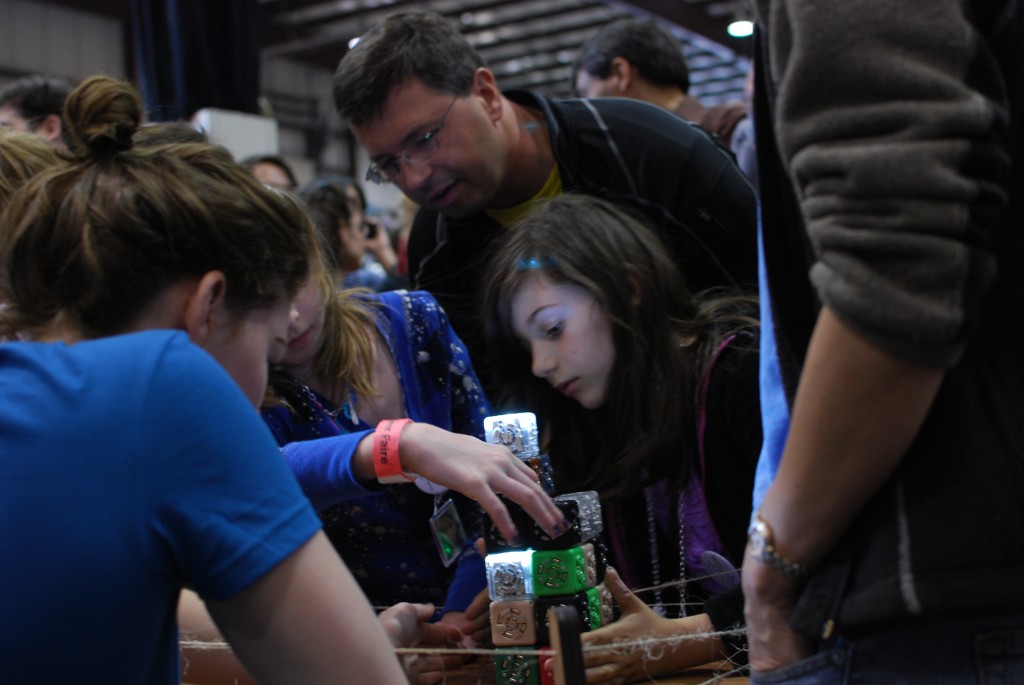 Maker Faire was something. We were expecting a crowd, but we weren’t expecting the madness created by thousands of kids clamoring for Cubelets over the two full days. It was amazing! Although the four of us that went to San Mateo are still a little exhausted, I’m happy to report that Cubelets are indeed tremendously fun to play with. Everyone was excited to build robots, from a few four-year-olds to a huge mass of 7-13 year olds, to a bunch of nerdy adults, and not just a few robot scientists. The mass of kids literally pushed our table back — we had to slide it forward every hour or so. And we got three Education Awards! I was so busy demo’ing that I barely had time to walk around, but there are a few photos of kids and robots on our Facebook page.
We learned a lot at our first Maker Faire and are looking forward to coming back with a bigger, badder (giant inflatable Cubelets?) setup. In the meantime, I’ve updated our FAQ with some of the more common questions from the last weekend. See you in NYC in September?
Maker Faire was something. We were expecting a crowd, but we weren’t expecting the madness created by thousands of kids clamoring for Cubelets over the two full days. It was amazing! Although the four of us that went to San Mateo are still a little exhausted, I’m happy to report that Cubelets are indeed tremendously fun to play with. Everyone was excited to build robots, from a few four-year-olds to a huge mass of 7-13 year olds, to a bunch of nerdy adults, and not just a few robot scientists. The mass of kids literally pushed our table back — we had to slide it forward every hour or so. And we got three Education Awards! I was so busy demo’ing that I barely had time to walk around, but there are a few photos of kids and robots on our Facebook page.
We learned a lot at our first Maker Faire and are looking forward to coming back with a bigger, badder (giant inflatable Cubelets?) setup. In the meantime, I’ve updated our FAQ with some of the more common questions from the last weekend. See you in NYC in September? 
